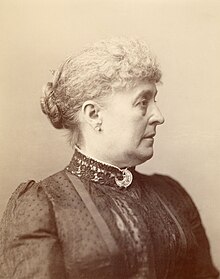
Back كارولين هاريسون Arabic كارولين هاريسون ARZ Karolina Harrison Azerbaijani Кэралайн Гарысан Byelorussian Caroline Harrisonová Czech Caroline Harrison German Caroline Harrison Spanish Caroline Harrison Basque کارولین هریسون Persian Caroline Harrison Finnish
Caroline Harrison | |
|---|---|
 Portrait by C. Parker, 1889 | |
| First Lady of the United States | |
| In role March 4, 1889 – October 25, 1892 | |
| President | Benjamin Harrison |
| Preceded by | Frances Cleveland |
| Succeeded by | Mary Harrison McKee (acting) |
| President General, National Society Daughters of the American Revolution | |
| In office 1890–1892 | |
| Preceded by | Office established |
| Succeeded by | Mary Virginia Ellet Cabell (Vice President presiding) |
| Personal details | |
| Born | Caroline Lavinia Scott October 1, 1832 Oxford, Ohio, U.S. |
| Died | October 25, 1892 (aged 60) Washington, D.C., U.S. |
| Resting place | Crown Hill Cemetery |
| Spouse | |
| Children | 3, including Russell and Mary |
| Parent |
|
| Education | Miami University (BM) |
| Signature | |
Caroline Lavinia Harrison (née Scott; October 1, 1832 – October 25, 1892) was an American music teacher and the first lady of the United States from 1889 until her death. She was married to President Benjamin Harrison, and she was the second first lady to die while serving in the role.
The daughter of a college professor, Harrison was well-educated, and she expressed interest in art, music, and literature throughout her life. She married Benjamin Harrison in 1853 and taught music while he engaged in a legal and political career. She was heavily involved in the community, working at her church, participating in charity work, and managing local institutions such as an orphanage and a women's club. During the Civil War, she contributed to the war effort through women's volunteer groups. When her husband was nominated for the presidency, she was a hostess as her home became the center of a front porch campaign.
As first lady, Harrison took little interest in her duties as hostess and dedicated much of her time to charity work. She was in favor of women's rights, and she co-founded the Daughters of the American Revolution, serving as its first President General. Harrison engaged in a major undertaking to renovate the White House, having much of its interior and utilities entirely redone. These renovations included the addition of electricity, though the family declined to use it for fear of electrocution. Her plans for the White House would later influence the construction of the East Wing and the West Wing. She also took inventory of furnishings and other possessions kept in the White House, beginning the practice of White House historical preservation.